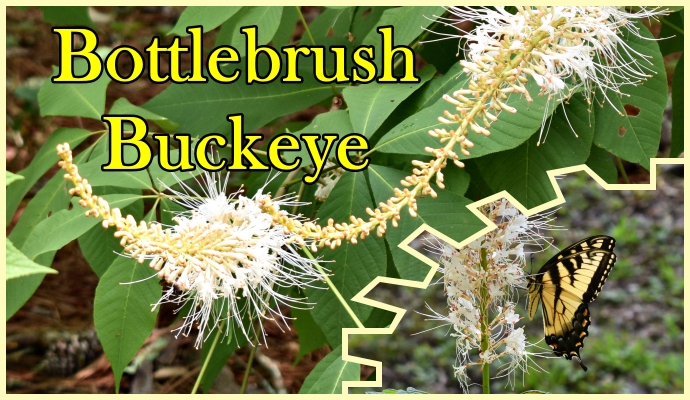Bottlebrush Buckeye is a glorious native shrub for the landscape. They are stunning in flower, particularly when used in mass or on a tall bank. Blooming in that gap period between the spring flush and the fall asters bottlebrush helps fill the need for a food source for pollinators during the hot summer months when there are fewer plants in flower. Right now, these shrubs are abuzz with bees; you might also see butterflies, particularly eastern swallowtails, and if you are observant enough, you might see a hummingbird darting among the flowers. The blossoms are creamy-white and look like candelabras that are 6 to 24” long panicles that start blooming from the bottom, gradually opening flowers until reaching the top.
This is a sun to part-shade plant for moist, well-drained, slightly acidic soil, but be prepared to give it room; it grows 6-10 feet and forms thickets that can grow as wide. Its native habitat is rich, moist woods and ravines. Bottlebrush buckeye can be used as shrubs in a hedgerow or as a specimen in the landscape. It is resistant to drought. It is deciduous, turning golden yellow in the fall—Hardy in zones 5 to 8.
A word of Caution! If eaten, all parts of this plant are highly poisonous to humans, cats, dogs, and horses. Toxicity depends on a person’s age, weight, physical condition, and individual susceptibility. Children are most vulnerable because of their curiosity and small size. The deer bit off half of the first flower stalk on mine; that was the only taste they needed to know they didn’t want anymore and did not cause further damage.
I bought mine at the Georgia Perimeter College Plant Sale in Decatur. Last year their Fall sale was on November 27. Fall is a great time to plant shrubs and you support the college’s horticulture program, a win-win. There is an extensive list of native plant sources on this website: https://gnps.org/georgias-native-plants/sources-native-plants/

